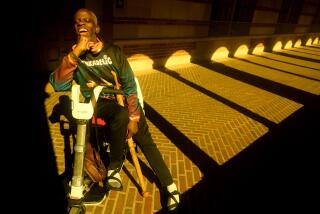Paul K. Longmore dies at 64; leading disability scholar and activist
- Share via
Unable to use his hands because of a childhood bout with polio, Paul K. Longmore wrote his first book by punching a keyboard with a pen he held in his mouth. It took him 10 years, and when he was done, he burned a copy in front of the Federal Building downtown.
By taking a match to “The Invention of George Washington” in 1988, the scholar brought national attention to a campaign to reform Social Security policies that discourage disabled professionals from working.
Some of the most restrictive penalties were soon lifted — including one preventing him from earning royalties on books — in a policy change that became known as the Longmore Amendment.
Longmore, a leading disability scholar and activist who taught at San Francisco State, died Aug. 9 of natural causes at his San Francisco home, said his sister, Ellen Brown. He was 64.
“He devoted his life to making this a better and more just world,” Robert A. Corrigan, the university’s president, said in a statement. “Legendary, inspirational, pioneering, irreverent … many words are needed to sum up this remarkable man.”
As a major founder of disability studies, Longmore helped establish it as a field of academic research and teaching.
In 1996, he helped start San Francisco State’s Institute for Disability Studies and was its director. Longmore worked to bring the discipline to other college campuses and provided leadership at disability rights rallies across the state and nation.
He also wrote some of the first academic and historical articles about how disabled people have been depicted in popular culture.
In his 2003 book, “Why I Burned My Book and Other Essays on Disability,” he challenged popular views of assisted suicide, which he had campaigned against legalizing in California, and highlighted the relatively unknown history of the disability rights movement during the Depression.
Last month, Longmore spoke at a San Francisco celebration of the 20th anniversary of the passage of the Americans With Disabilities Act and reminded the crowd of a perspective he had long espoused: Disability rights activists had brought about change by redefining what it means to be disabled.
The movement recast “disability” as “a problem located mainly out there in society” that had to be dealt with, Longmore had said, whether it meant improving access by placing wheelchair-accessible ramps on curbs or elevators in buildings.
Stephen Rosenbaum, a staff attorney for the advocacy group Disability Rights California, said in a statement: “I once heard Paul introduced as the ‘ James Dean’ of disability studies. That captures the combination of intellectual, rebel and down-to-earth man he was.”
Paul Kenneth Longmore was born July 10, 1946, in Mount Holly, N.J., to Kenneth and Evelyn Longmore. His family moved up and down the West Coast for his father’s career as a Baptist minister.
At 7, Longmore came down with polio, which paralyzed his arms and severely curved his spine. He used a ventilator for as long as 18 hours a day.
He attended special-education classes in elementary school, but his parents and teacher successfully pushed for him to attend his local junior high.
Before sending him off, his teacher told him: “ ‘You have to succeed. If you don’t, they won’t let others in. You’re a pioneer.’ And I’ve never forgotten that. Every school and every job, I’ve always been the first with a major disability,” Longmore said in a 1991 news release from Stanford University, where he once taught.
Longmore studied history at Occidental College, earning a bachelor’s degree in 1968 and later a master’s.
While studying history at Claremont Graduate University, Longmore audited a USC class on policy-making about disability and helped develop a program on disability and society.
The experience made him realize he could apply his training as a historian to the study of disability history, Longmore later said.
In college, he was repeatedly discouraged from teaching because of his disability and had trouble getting financial help, he later said. Eventually, a member of the state Legislature helped Longmore secure funding for a Dictaphone and a transcriptionist.
“The quality of my work improved, and I said to myself, ‘Well, you’re not lazy. You just didn’t have the means to do it,’” he told the Washington Post in 1991. It was an epiphany that shaped his perspective as a disability rights activist.
“I relocated the problem from me to outside of me, which is part of the transition any member of a minority group has to go through,” he said.
After earning his doctorate in 1984, Longmore taught at USC and delved into advocacy for the disabled. In 1990, he went to Stanford on a two-year fellowship and in 1993 joined San Francisco State.
“When I was growing up, I was the only visible disabled person I saw,” Longmore told the San Francisco Chronicle in 2005. “Now you see disabled people all around. … People with disabilities ought to be able to participate in society, and we did that. We changed American values.”
Longmore, who was divorced, is survived by his sister.
valerie.nelson@latimes.com
More to Read
Start your day right
Sign up for Essential California for the L.A. Times biggest news, features and recommendations in your inbox six days a week.
You may occasionally receive promotional content from the Los Angeles Times.







